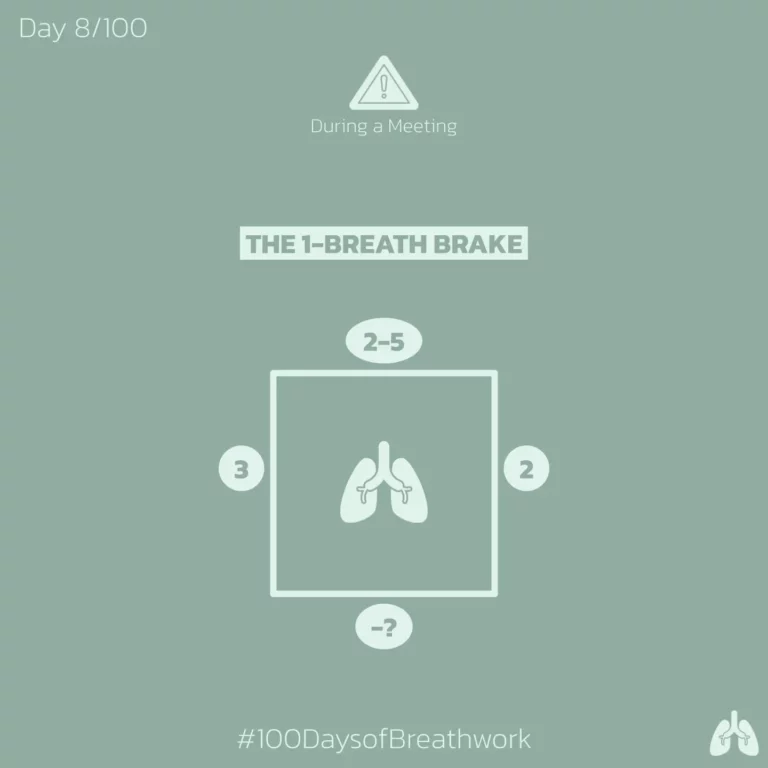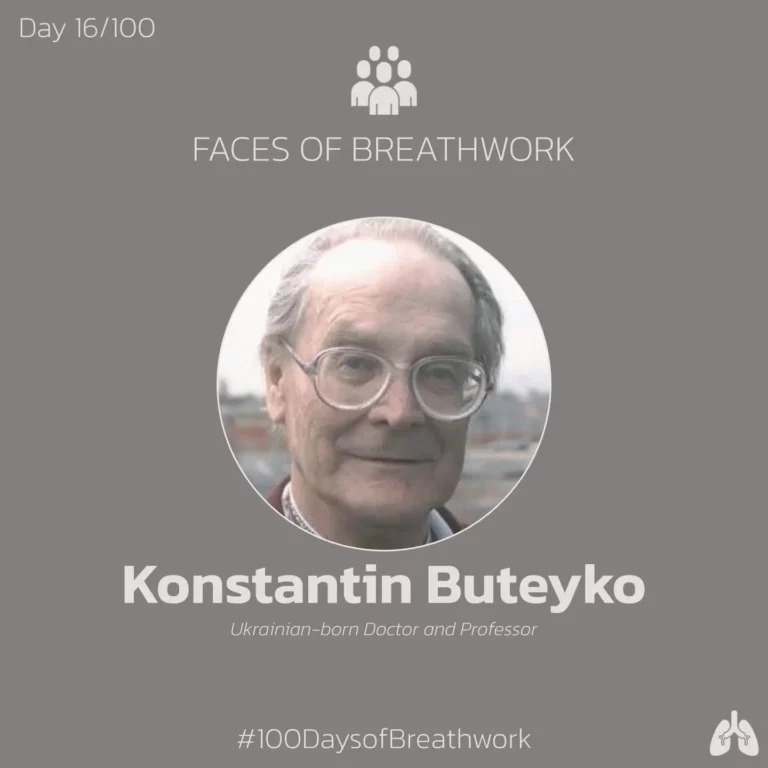100 Days of Breathwork: Recap of Days 13-18
Last week, we got to know Tummo Breathing and the history surrounding this breathing technique. We also got to meet Wim Hof, a breathwork powerhouse and overall energetic spirit in the field of health and wellness. This week, we get to learn about Nasal Breathing and meet another (re-)pioneer in Breathwork.
Day 13: History of Breathwork
Nasal Breathing in indigenous societies
Ancient cultures around the world—-including India, China, Native America—-treated breathing as a form of medicine. They believed it to be a sacred thing, as important as other systems of health. Evidence for this exists in various writings, practices, understandings, appreciations for it.
From James Nestor’s book “Breath: the New Science of a Lost Art” – in the 1830s, a man named George Catlin traveled west to live with Native American tribes. This was before western culture crept into their lives (introduction of alcohol and western food influences). In every tribe, they considered nasal breathing as the fountain of health. They explained to Catlin that “breath inhaled through the mouth sapped the body of strength, deformed the face, and caused stress and disease. On the other hand, breath inhaled through the nose kept the body strong, made the face beautiful, and prevented disease.” He also wrote that mothers would calmly shut the mouths of infants if they were mouth-breathing, or stand over them while sleeping and watch to ensure their mouths were shut. It is clear that health benefits from breathing through nose-breathing had been embedded in their culture for thousands of years.
Day 14: Situational Breathwork
Breathing During a Meeting
As a reminder, we use a “four corners of breath” notation to explain our breathwork as seen below. (image to be added after the draft)
Each side of the box indicates a ~1 second count. For example, a 4-4-4-4 pattern would look like: (image to be added after the draft)
Last week, our situation was a technique to do before a big meeting; today’s post will be a technique to use DURING a meeting. Of course, this likely means you aren’t the focal point of the meeting. Unless you want things to get weird. So you’re in a meeting, and something just activated your stress response. As if entering fight/flight mode, your face flushes, your heart beats faster, your mind races, and focus is lost.
Our breathwork technique that is perfect for this scenario comes from biohacker/author Kasper van der Meulen and his book Mindlift: Mental Fitness for the Modern Mind.
Called the 1-BREATH BRAKE, and, as its name suggests, it acts as an emergency brake on your stress response to calm your nervous system. The best part about it? It’s so subtle that nobody will know you’re doing it.
So, here’s how to do it:
- Start with a full in-breath, about 3 seconds.
- Hold this for 2-5 seconds.
- Let it go with a relaxed sigh (inaudible if you can; let’s not draw attention to ourselves), taking about 2 seconds.
- Then hold as long as you can (notated by the ‘-?’ below).

There are two ‘main’ physiological things that happen during this technique:
- You stimulate your vagus nerve, which helps you calm down (bringing you back from sympathetic (fight/flight) to parasympathetic (rest/digest/socialize) nervous system
- Your bronchi open up slightly to make the gas exchange a bit easier in your lungs
As Kasper describes: “The conscious inhale breaks my pattern, the hold dilates those bronchi and pushes the “parasympathetic button”, the relaxplosion (that’s totally a word) releases some tension and the exhale retention holds some quiet space for a mindful mental reset. Also, it allows the CO2 levels to stabilize and Nitric Oxide to build up so that the next inhale will be received more optimally.”
Day 15: Science of Breathwork
How breathwork influences the Sympathetic Nervous System
Today, let’s dive into the Sympathetic Nervous System, which is one of two systems that are dictated by our Autonomic Nervous System, or ANS (and FYI, the second is the Parasympathetic Nervous System).
The Sympathetic Nervous System is commonly known as the “Flight or Flight” response and is typically associated with a “stressed” state. Often, our ANS activates this state given environmental and situational cues — such as perceived threats of danger, temperature, sounds, and many others. The ANS also has the ability to govern how our physical body reacts, which includes things like our pace of breathing, heartbeat, sweat, blood glucose level, and others.
Next, we will outline the different bodily functions when the ANS activates the Sympathetic Nervous System
Sympathetic Nervous System Fight or Fligh
- Dilates pupils
- Inhibits saliva
- Inhibits the activity of the stomach
- Increases blood glucose
- Increase heartbeat
- Dilates blood vessels
- Inhibits urination
- Speeds up the pace of breathing
As I mentioned, it’s often environmental cues that cause our ANS to activate the Sympathetic Nervous System. However, there’s one other known way that can do this; one that goes against the traditional belief around—and namesake of—the Autonomic Nervous System. And that’s breathwork.
How does conscious breathing, or breathwork, communicate with our Autonomic Nervous System? For one, simply changing our rate of breathing influences our brain activity, primarily because our brainstem breathing centers are very close to the brain centers that regulate mood/emotions.
Another way is through the vagus nerve, which is a cranial r Terve complex that relays information to the ANS and can be modulated by breathing. Since we can control how we breathe, there are many ways we can stimulate the vagus nerve – thus influencing the signals it sends to the ANS. It’s like a two-way radio if you’re into 20th-century metaphors. For example, a long exhale encourages the vagus nerve to send signals to relax.
Many breathwork techniques we discuss are doing exactly this: altering the signal the vagus nerve sends to our ANS.

Day 16: Faces of Breathwork
Dr. Konstantin Buteyko
Dr. Konstantin Buteyko is the founder of the Buteyko Breathing Method, something that has changed the lives of thousands of people with asthma, sleep apnea, snoring, and other breathing disorders. Given his Ukrainian origin, I thought it would be relevant to give Buteyko the nod for this week’s ‘Faces of Breathwork’ (although I do acknowledge most of his work was completed in the USSR).
In the late 1940s, Buteyko noticed that many of his patients’ health deteriorated when their breathing rate increased. He also noticed that those who reduced their breathing rate began to recover. Based on this observation – and his subsequent research – he developed the breathing techniques that make up the Buteyko Method.
The Buteyko Method
This method helps treat a wide range of health conditions, in particular asthma and sleep apnea by utilizing:
- nasal breathing
- breath control
- breath-holding exercises
People have also used the Buteyko Method to improve blood circulation, stress, anxiety, and general health.
A note from me: I find it interesting that it took a Western medicine doctor into the 1980s to establish credibility around the health benefits of nasal breathing. As we discussed on Day 13, this was something that was practiced as a form of medicine by indigenous societies for thousands of years prior. Just a thought to ponder.
Day 17: Breathwork Session
Monday March 7th
We went LIVE on LinkedIn!
And if you want to see someone struggle to navigate their first ever LIVESTREAM, only to ultimately save it with an amazing, refreshing breathwork session, then click this link and scroll to Day 11 to watch recording of the session!
Every Monday morning at 7:15am ET, we’ll be hosting a session to kick off the week the right way – with a breathwork session to calm stress, reduce anxiety, and increase focus.
Day 18: Common Questions
What is the best time of day to do breathwork?
There are differing opinions on this topic of WHEN to do breathwork. I’ll give you mine.
I’ve tried breathwork at all times of the day—morning, middle, and night. I’ve tried it before a workout, in the middle of a workout, after a Workout. I’ve done it on an empty stomach and right after a meal.
In my opinion: when I’m doing a super ventilation style of breathwork (like Wim Hof), in the morning, on an empty stomach is most impactful for me, especially to clear my head and prepare for the day ahead.
Middle of the day is just okay; sometimes I’m tense from work or other thoughts rolling around in my head. And my food level is unpredictable throughout the day.
Nighttime for this type of breathwork does not Work well for me, as it wakes me up and brings focus (not conducive to sleeping). Another breathwork technique, like a 4-7-8 by Andrew Weil, to downregulate your nervous system may be best.
Conclusion
Breathwork has always captured the interest of both ancient practitioners and modern researchers alike. Because of its many tangible positive effects, this is unsurprising. Now you too can benefit from these life-changing events whenever and wherever you need it.
